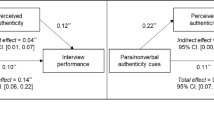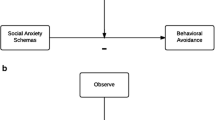Abstract
Purpose
The aim of this study was to investigate (a) the behavioral cues that are displayed by, and trait judgments formed about, anxious interviewees, and (b) why anxious interviewees receive lower interview performance ratings. The Behavioral Expression of Interview Anxiety Model was created as a conceptual framework to explore these relations.
Design/Methodology/Approach
We videotaped and transcribed mock job interviews, obtained ratings of interview anxiety and interview performance, and trained raters to assess several verbal and nonverbal cues and trait judgments.
Findings
The results indicated that few behavioral cues, but several traits were related to interviewee and interviewer ratings of interview anxiety. Two factors emerged from our factor analysis on the trait judgments—Assertiveness and Interpersonal Warmth. Mediation analyses were performed and indicated that Assertiveness and Interpersonal Warmth mediated the relation between interview anxiety and interview performance. Speech rate (words spoken per minute) and Assertiveness were found to mediate the relation between interviewee and interviewer ratings of interview anxiety.
Implications
Overall, the results indicated that interviewees should focus less on their nervous tics and more on the broader impressions that they convey. Our findings indicate that anxious interviewees may want to focus on how assertive and interpersonally warm they appear to interviewers.
Originality/Value
To our knowledge, this is the first study to use a validated interview anxiety measure to examine behavioral cues and traits exhibited by anxious interviewees. We offer new insight into why anxious interviewees receive lower interview performance ratings.

Similar content being viewed by others
Notes
We thank an anonymous reviewer for the title of the model.
References
Alden, L. E., & Bieling, P. J. (1998). Interpersonal consequences of the pursuit of safety. Behavior Research and Therapy, 36, 53–64.
Alden, L. E., & Taylor, C. T. (2004). Interpersonal processes in social phobia. Clinical Psychology Review, 24, 857–882.
Ambady, N., & Rosenthal, R. (1993). Half a minute: Predicting teacher evaluations from thin slices of nonverbal behavior and physical attractiveness. Journal of Personality and Social Psychology, 64, 431–441.
Andersen, P., Hecht, M., Hoobler, G., & Smallwood, M. (2002). Nonverbal communication across cultures. In W. B. Gudykunst & B. Mody (Eds.), Handbook of International and Intercultural Communication (2nd ed., pp. 89–106). London: Sage.
Ayres, J., & Crosby, S. (1995). Two studies concerning the predictive validity of the personal report of communication apprehension in employment interviews. Communication Research Reports, 12, 145–151.
Ayres, J., Keereetaweep, T., Chen, P. E., & Edwards, P. A. (1998). Communication apprehension and employment interviews. Communication Education, 47, 1–17.
Baron, R. M., & Kenny, D. A. (1986). The moderator-mediator distinction in social psychological research: Conceptual, strategic, and statistical considerations. Journal of Personality and Social Psychology, 51, 1173–1182.
Barrick, M. R., Patton, G. K., & Haugland, S. N. (2000). Accuracy of interviewer judgments of job applicant personality traits. Personnel Psychology, 53, 925–951.
Barrick, M. R., Shaffer, J. A., & DeGrassi, S. W. (2009). What you see may not be what you get: Relationships among self-presentation tactics and ratings of interview and job performance. Journal of Applied Psychology, 94, 1394–1411.
Bellack, A. S. (1983). Recurrent problems in the behavioral assessment of social skill. Behavior Research and Therapy, 21, 29–41.
Bolino, M. C., Kacmar, K. M., Turnley, W. H., & Gilstrap, J. B. (2008). A multi-level review of impression management motives and behaviors. Journal of Management, 34, 1080–1109.
Borkenau, P., & Liebler, A. (1992). Trait inferences: Sources of validity at zero acquaintance. Journal of Personality and Social Psychology, 62, 645–657.
Brown, M. A., & Stopa, L. (2007). The spotlight effect and the illusion of transparency in social anxiety. Journal of Anxiety Disorders, 21, 804–819.
Brunswik, E. (1956). Perception and the representative design of psychological experiments (2nd ed.). Berkeley, CA: University of California Press.
Burgoon, J. K., Pfau, M., Birk, T., & Manusov, V. (1987). Nonverbal communication performance and perceptions associated with reticence: Replications and classroom implications. Communication Education, 36, 119–130.
Chambers, R. L., & Skinner, C. J. (Eds.). (2003). Analysis of survey data. New York: Wiley.
Cheek, J. M., & Buss, A. H. (1981). Shyness and sociability. Journal of Personality and Social Psychology, 41, 330–339.
Clark, D. M., & Wells, A. (1995). A cognitive model of social phobia. In R. G. Heimberg, M. Liebowitz, D. A. Hope, & F. R. Schneier (Eds.), Social phobia: Diagnosis, assessment and treatment (pp. 69–93). New York: Guilford Press.
Cook, M. (1969). Anxiety, speech disturbances, and speech rate. British Journal of Social and Clinical Psychology, 8, 13–21.
Cook, K. W., Vance, C. A., & Spector, P. E. (2000). The relation of candidate personality with selection-interview outcomes. Journal of Applied Social Psychology, 30, 867–885.
Cuddy, A. J. C., Glick, P., & Beninger, A. (2011). The dynamics of warmth and competence judgments, and their outcomes in organizations. Research in Organizational Behavior, 31, 73–98.
Dalal, D. K., Dalia, L. D., Balzer, W. K., & Doherty, M. E. (2010). The lens model: An application of JDM methodologies to IOOB practice. Industrial and Organizational Psychology, 3, 424–428.
DeGroot, T., & Gooty, J. (2009). Can nonverbal cues be used to make meaningful personality attributions in employment interviews? Journal of Business and Psychology, 24, 179–192.
DeGroot, T., & Motowildo, S. J. (1999). Why visual and vocal interview cues can affect interviewers’ judgments and predict job performance. Journal of Applied Psychology, 84, 986–993.
Eden, D., & Aviram, A. (1993). Self-efficacy training to speed reemployment: Helping people to help themselves. Journal of Applied Psychology, 78, 352–360.
Ellis, A. P. J., West, B. J., Ryan, A. M., & DeShon, R. P. (2002). The use of impression management tactics in structured interviews: A function of question type? Journal of Applied Psychology, 87, 1200–1208.
Feiler, A. R., & Powell, D. M. (2013). Interview anxiety across the sexes: Support for the sex-linked anxiety coping theory. Personality and Individual Differences, 54, 12–17.
Forbes, R. J., & Jackson, P. R. (1980). Nonverbal behavior and the outcome of selection interview outcomes. Journal of Occupational Psychology, 53, 65–72.
Fugita, S. S., Wexley, K. N., & Hillery, J. M. (1974). Black-white differences in nonverbal behavior in an interview setting. Journal of Applied Social Psychology, 4, 343–350.
Goffin, R. D., Jelley, R. B., Powell, D. M., & Johnston, N. G. (2009). Taking advantage of social comparisons in performance appraisal: The relative percentile method. Human Resource Management, 48, 251–268.
Gosling, S. D., Ko, S. J., Mannarelli, T., & Morris, M. E. (2002). A room with a cue: personality judgments based on offices and bedrooms. Journal of Personality and Social Psychology, 82, 379–398.
Gough, H. G., & Thorne, A. (1986). Positive, negative, and balanced shyness: Self-definitions and the reactions of others. In W. H. Jones, J. M. Cheek, & S. R. Briggs (Eds.), Shyness: Perspectives on research and treatment (pp. 205–225). New York: Plenum.
Gurtman, M. B. (2009). Exploring personality with the interpersonal circumplex. Social and Personality Psychology Compass, 3, 601–619.
Harrigan, J. A., Wilson, K., & Rosenthal, R. (2004). Detecting state and trait anxiety from auditory and visual cues: A meta-analysis. Personality and Social Psychology Bulletin, 30, 56–66.
Heck, R. (2001). Multilevel modeling with SEM. In G. A. Marcoulides & R. E. Schumacker (Eds.), New developments and techniques in structural equation modeling (pp. 89–127). Hillsdale, NJ: Erlbaum.
Heimberg, R. G., Keller, K. E., & Peca-Baker, T. (1986). Cognitive assessment of social-evaluative anxiety in the job interview: Job interview self-statement schedule. Journal of Counseling Psychology, 33, 190–195.
Hollandsworth, J. G., Glazeski, R. C., & Dressel, M. E. (1978). Use of social-skills training in the treatment of extreme anxiety and deficient verbal skills in the job interview setting. Journal of Applied Behavior Analysis, 11, 259–269.
Horowitz, L. M., Wilson, K. R., Turan, B., Zolotsev, P., Constantino, M. J., & Henderson, L. (2006). Personality and Social Psychology Review, 10, 67–86.
Huffcutt, A. I., Van Iddekinge, C. H., & Roth, P. L. (2011). Understanding applicant behavior in employment interviews: A theoretical model of interviewee performance. Human Resource Management Review, 21, 353–367.
Kervyn, N., Yzerbyt, V. Y., Judd, C. M., & Nunes, A. (2009). A question of compensation: The social life of the fundamental dimensions of social perception. Journal of Personality and Social Psychology, 96, 828–842.
Kiesler, D. J. (1996). Contemporary interpersonal theory and research. New York, NY: Wiley.
Kim, E. J. (2005). The effect of the decreased safety behaviors on anxiety and negative thoughts in social phobics. Anxiety Disorders, 19, 69–86.
Klie, S. (2008). More men in HR would boost profession: Survey. Canadian HR Reporter, 21, 12.
Leary, M. R. (1983). Understanding social anxiety: Social, personality and clinical perspectives. Beverly Hills, CA: Sage Publications.
Levine, S. P., & Feldman, R. S. (2002). Women and men’s nonverbal behavior and self- monitoring in a job interview setting. Applied H.R.M Research, 7, 1–14.
Macan, T. (2009). The employment interview: A review of current studies and directions for future research. Human Resource Management Review, 19, 203–218.
McCarthy, J. M., & Goffin, R. D. (2004). Measuring job interview anxiety: Beyond weak knees and sweaty palms. Personnel Psychology, 57, 607–637.
McGraw, K. O., & Wong, S. P. (1996). Forming inferences about some intraclass correlation coefficients. Psychological Methods, 1, 30–46.
Mersch, P. P. A., Emmelkamp, P. M. G., Bogels, S. M., & Van der Sleen, J. (1989). Social phobia: Individual response patterns and the effects of behavioral and cognitive interventions. Behavior Research and Therapy, 27, 421–434.
Oliver, T., Hausdorf, P., Lievens, F., & Conlon, P. (2014). Interpersonal dynamics in assessment center exercises: Effects of role player portrayed disposition. Journal of Management,0149206314525207.
Papsdorf, M., & Alden, L. (1998). Mediators of social rejection in social anxiety: Similarity, self-disclosure, and overt signs of anxiety. Journal of Research in Personality, 32, 351–369.
Pilkonis, P. A. (1977). The behavioral consequences of shyness. Journal of Personality, 55, 596–611.
Pontari, B. A. (2009). Appearing socially competent: The effects of a friend’s presence on the socially anxious. Personality and Social Psychology Bulletin, 35, 283–294.
Preacher, K. J., & Hayes, A. F. (2004). SPSS and SAS procedures for estimating indirect effects in simple mediation models. Behavior Research Methods, Instruments, & Computers, 36, 717–731.
Russell, B., Perkins, J., & Grinnell, H. (2008). Interviewees’ overuse of the word “like” and hesitations: Effects in simulated hiring decisions. Psychological Reports, 102, 111–118.
Schlenker, B. R., & Leary, M. R. (1982). Social anxiety and self-presentation: A conceptualization and model. Psychological Bulletin, 92, 641–669.
Sieverding, M. (2009). ‘Be cool!’ Emotional costs of hiding feelings in a job interview. International Journal of Selection and Assessment, 17, 391–401.
Swider, B. W., Barrick, M. R., Harris, B., & Stoverink, A. C. (2011). Managing and creating an image in the interview: The role of interviewee initial impressions. Journal of Applied Psychology, 96, 1275–1288.
Tickle-Degnen, T., & Rosenthal, R. (1990). The nature of rapport and its nonverbal correlates. Psychological Inquiry, 1, 285–293.
Van Dam, K. (2003). Trait perception in the employment interview: A five-factor model perspective. International Journal of Selection and Assessment, 11, 43–55.
Wiggins, J. S. (1979). A psychological taxonomy of trait-descriptive terms: The interpersonal domain. Journal of Personality and Social Psychology, 37, 395–412.
Acknowledgement
Special thanks to Monika Nadj for her contribution with developing an earlier version of the micro cue scale. This research was supported by a Grant from the Social Sciences and Humanities Research Council of Canada to Deborah Powell.
Author information
Authors and Affiliations
Corresponding author
Additional information
Amanda R. Feiler and Deborah M. Powell have equally contributed to the study and manuscript.
Rights and permissions
About this article
Cite this article
Feiler, A.R., Powell, D.M. Behavioral Expression of Job Interview Anxiety. J Bus Psychol 31, 155–171 (2016). https://doi.org/10.1007/s10869-015-9403-z
Published:
Issue Date:
DOI: https://doi.org/10.1007/s10869-015-9403-z




